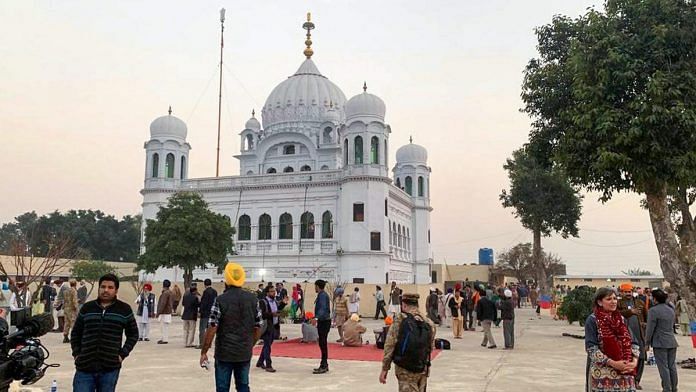New Delhi: The Kartarpur Corridor between India and Pakistan has been delayed for years owing to India’s security concerns. But now that the project is being constructed for Sikh pilgrims to be able to visit the Gurudwara Darbar Sahib for Guru Nanak’s 550th birth anniversary celebrations later this year, a new concern has emerged — the safety of the pilgrims.
As part of the project on the Pakistani side, a new channel has been dug for the river Ravi, but satellite images show that it could cause a flood-like situation near the India-Pakistan border.

ThePrint takes a look at this concern and other parts of the project through the latest satellite images.
Significance of Kartarpur shrine
Since Navjot Singh Sidhu’s hug to Gen. Qamar Javed Bajwa in August last year, the Kartarpur Corridor has been one of the hottest topics of discussion between India and Pakistan.
On either side of the Pulwama terror attack and the Balakot air strikes, the two neighbours have remained locked in conversation about the long-awaited corridor.
The gurudwara, built by Sikhism founder Guru Nanak in 1522, is his final resting place — he died there on 22 September 1539. The original structure was destroyed by floods in the nearby Ravi river, and reconstructed in 1925 by Bhupinder Singh, the then-Maharaja of Patiala.
At present, most Sikh pilgrims do ‘darshan’ of the Darbar Sahib from a viewing stage built in Dera Baba Nanak on the Indian side.
Also read: China has flattened Uyghur cemeteries to build roads, ecological parks & high-rises
A new bridge and channel for the Ravi
Satellite images show that a new bridge has been constructed over the Ravi. In June, there were two spans yet to be constructed, but in July, the bridge is almost complete.

The new bridge is 770m long, 12.5m wide, has a span length of 35m and 20 piers. However, the embankments of the bridge do not appear to be very strong.
Another cause for concern noticed on recent imagery is the channelisation of the Ravi. A large channel, almost 2km long and 50m wide, has been dug out to shorten the river’s flow. The channel has been cut without any lining or supporting structure.

What’s more, the Pakistani engineers first dug one channel, and then a second one just 300m south of it, in the space of about a month.

The water always flows in the direction of least resistance. All the rivers of Punjab — in India and Pakistan — flow from north-east to south-west.
Since there are no embankments and no retainer wall to control river bank failure, the channel could certainly get wider, as the side walls will wither under the Ravi’s flow, especially during the monsoon. This could then threaten the stability of the piers and abutments by scouring the stream heads and degrading the channel.
The divergent guidebanks, which are supposed to guide the river under the bridge, are not yet supported by riprap (stones that form a kind of support), and also not yet fully connected to the bridge embankments. The northern guidebank doesn’t have a head, suggesting it will be difficult to train the river to follow the new course.
With the new channel being very close to the previous route of the river, it can be assessed that the course may not go northwards as expected by Pakistani engineers, but could possibly travel south to follow the old route, possibly creating a flood-like situation near the border.
Customs posts and causeway
Satellite images show three barracks constructed for reception and documentation of pilgrims on the Pakistani side of the corridor. These are likely to be manned by customs and security personnel. No other infrastructure for management of pilgrims can be observed at this location.

This indicates that the journey of the pilgrims from the border to the shrine is not likely to be very smooth.
The road from the Indian border to the Darbar Sahib is a causeway, like those generally observed in the plains of Punjab — it is almost 5-10m higher than the ground around it. The elevated road would stop river water overflowing from the recently-constructed channel, and will certainly create a flood-like situation, endangering pilgrims’ lives.

The Indian government has raised genuine concerns regarding the causeway being constructed instead of a proper bridge. Such a bridge would have allowed Indian citizens to travel to and from the shrine without coming in contact with any Pakistani citizens, especially intelligence agencies, during the pilgrimage.
Renovation and beautification
Recent satellite images show the entire area around the main Gurudwara Darbar Sahib has been cleared, with smaller buildings and sarais (rest houses) removed. The entire area is being paved.

An area of 250m x 250m is being prepared around the sanctum sanctorum, with a sarai wall all around. The sarai wall will possibly contain offices, kitchens, langar (community kitchen) and halls for pilgrims.
A separate possible sarai of 240m length is also being constructed on the eastern side of the shrine.
The outer wall has four large gates, similar to the Golden Temple in Amritsar. The zone is being beautified, with a large garden towards the Indian side.
Progress slow on the Indian side
The progress on the Indian side of the corridor is slower than on the other side.
The area for the reception of pilgrims and the Indian customs post is being cleared near the city of Dera Baba Nanak. A very large approach road is being constructed from the state highway to the border, bypassing the city.
Also read: It’s not just Chennai, India’s drying lakes crisis has spread far and wide






